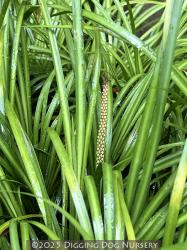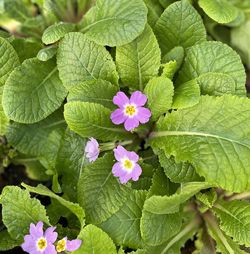Including Calamagrostis & Carex
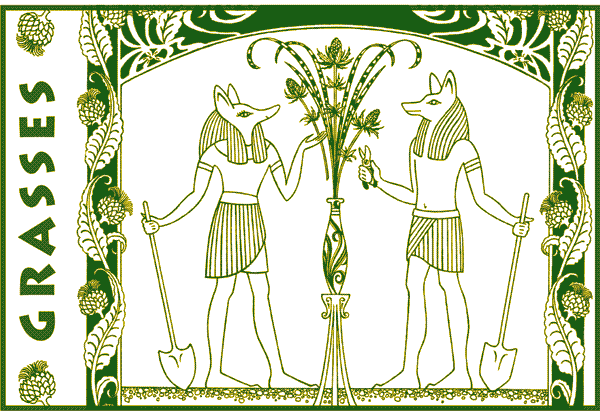
One of the most exciting trends in contemporary American landscaping is the recent availability of a wide variety of ornamental grasses. Grasses offer more than longevity and low maintenance: they bring movement, fall and winter pizzazz, lush volume, texture and line, and even sound, to any situation. The design possibilities are mind-boggling!
Plant grasses for a stunning effect in groups by themselves, with wildflowers for a stylized meadow, as a transition area between surrounding fields or woods and the garden proper, or be even bolder and bring some into the perennial bed for vertical excitement. Think of them as shrub substitutes for hedges and semi-transparent screens, as specimens to contrast with rocks and boulders, and by all means, place a few at water's edge. Show grasses to best effect by backlighting, so that every tiny seed and hairlike filament seems illuminated from within. Ornamental grasses are simply unbeatable fresh or dried in arrangements, with flowers or by themselves.
To prevent rotting during the rainy season, plant ornamental grasses high enough to ensure drainage away from the base of the plant. Wait until late winter or until they no longer look great, then shear ruthlessly to 4 or 6 inches. Divisions are necessary at least every three years. Once established, many grasses will reward you by being drought and heat resistant.
Please note some of the given bloom times have been extended beyond the actual flowering period to include the interesting dried effect of the inflorescences in winter.
Acorus
Grassy-Leaved Sweet Flag
Named for the pleasant pine-like fragrance emanating from its dapper semievergreen fans, Acorus is actually not a grass, but rather a grassy-looking herbaceous perennial. This deer-resistant Asian denizen eventually forges a dense trouble-free ground cover of waxy, upright flattened blades that grow from slow-creeping rhizomes. Recently included in the Acoraceae family and once used as an aromatic addition to gin, beer and perfumes, it craves consistently moist soil, flourishing in both boggy situations and even shallow standing water.
Each $11.00
Acorus gramineus ‘Minimus Aureus’ (G-0593)
Each $11.00
The adorable fine-hewn tufts of lustrous, curved yellow-green blades impart a lambent pixie-like charm, while wafting a sweet scent. Happiest in moist niches with protection from hot summer sun, this easily grown diminutive perennial can be nestled between contrasting dark steps, cozied alongside smaller rocks or tucked into pint-sized patio containers.
Blooms May–June
Size: 3" high x 5" – 15" wide.
Hardy to zone 5.
Acorus gramineus ‘Variegatus’ (G-0460)
Each $11.00
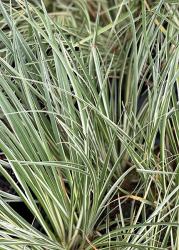
Neat alabaster-striped margins jazz up ‘Variegatus’s slim linear leaf-blades. An undemanding, redolent moisture-lover, the rounded, glossy Iris-like clump makes a lively low growing addition to damp shady borders or water’s edge.
Blooms May–June
Size: 8" – 12" high x 18" – 2' 0" wide.
Hardy to zone 5.
Ampelodesmos
Mauritania Vine Reed
Ampelodesmos mauritanicus (G-0479)
Each $11.00
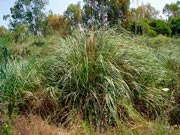
A Mediterranean denizen, this stately grass yields fine textured evergreen blades tough enough to fashion ties, ropes and baskets, and large enough to make an imposing focal point in your mixed border. Lofty upward arching stems race skyward, asserting mostly one-sided pearl-colored panicles above a dark green clump-forming mound, while airy purple-flushed inflorescences invite birds and gardeners alike. Robust Rope Grass maintains its majestic composure throughout the winter and requires a sheltered, sunny position with well-drained soil.
Blooms July–November
Size: 9' 0" high x 3' 0" – 4' 0" wide.
Hardy to zone 8.
Andropogon
This large cosmopolitan genus gleans its name from the Greek word pogon, or beard, alluding to the lustrous hairs that blanket the inflorescences. Closely associated with Schizachyrium, 13 clump-forming warm season Andropogon hail from North America. Many of the garden-worthy Beardgrass are often drought tolerant, and generally characterized by attractive, easily grown sturdy demeanors, late summer blooms plus stunning autumn color.
Each $12.75
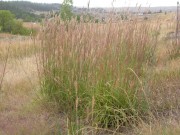
Historically renowned as the sod our ancestors broke their backs busting, Big Bluestem is the most widespread of all the prairie grasses. Its regal and wild color show makes it a must in our garden. Growing to great size, the stand’s lush, blue-blushed summer greenery becomes a burgundy and copper glory at first frost. Soaring three-pronged red seed heads beg its other common name, Turkeyfoot.
Reliable, heat tolerant and sturdy, Andropogon gerardii thrives in poorly drained clay to dry sandy soils, and easily transitions the outskirts of your garden into the wild meadow beyond.
Blooms late August–October
Size: 5' 0" – 8' 0" high x 3' 0" wide.
Hardy to zone 4.
Andropogon gerardii ‘Holy Smoke’ (G-0605)
Each $12.75
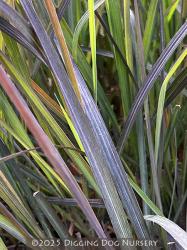
Prismatic three season appeal and a steely attitude are the hallmark of this long-lived Intrinsic Perennial Gardens introduction. Tall, straight, sturdy stems plus upright arching blades emerge in glaucous bluish green tones, which transition to a greener coloration with maroon mottling as the weather warms, while breathtaking bronze, burgundy, smoky purple and mulled pink herald autumn. Well suited for mixed borders, meadow-style gardens and naturalized areas, drought-tolerant ‘Holy Smoke’ helps control erosion, delivers distinctive 3-parted blooms enjoyed by birds as well as flower arrangers and looks most effective en masse, especially alongside other native chums like Echinacea ‘Ruby Star’ or Liatris ligulistylis. (pp#33,929)
Blooms August–October
Size: 4' 0" – 6' 0" high x 2' 0" – 2-1/2' wide.
Zone 3b/4.
Andropogon gerardii ‘Karl′s Cousin®’ (G-0604)
Each $12.75
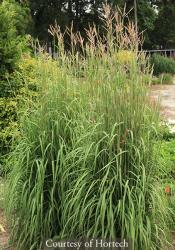
Spotted by green-roof expert Dave MacKenzie while driving in the wilds of northern Michigan, this relatively new nonflopping native soldiers a close-knit erect posture that mimics Calamagrostis ‘Karl Foerster′s straight-backed habit, and thus earns its name. An exceptional narrow column of broad, tapered green-blue leaves plus valiant stalks elevates the airy tribranched red inflorescences. Suffused with eye-catching cozy plum and wine shades as the season progresses, resilient ‘Karl′s Cousin’ promotes nearly year-round vertical elements, appreciates lean well-drained soil and can be planted sentinel-like or massed in mixed borders plus readily nudged into tight nooks.
Blooms July–October
Size: 6' 0" – 7' 0" high x 2' 0" wide.
Hardy to zone 4.
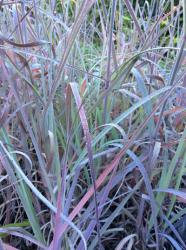
Spotted near Crowley, TX by John Snowden, acclaimed grass expert and Bluestem Nursery founder, this American native’s unwavering fortitude belies its graceful lush-looking silhouette. Thick, straight bluish mauve-hued stalks supporting narrow, 3-pronged rubescent inflorescences emerge from large, upright ¼ in. wide powder-blue blades, which broadcast reddish purple, dusky-pink, tangerine and copper tones in September. A carefree color-rich candidate for dry sunny locales, ‘Lord Snowden’ can be massed or planted as a specimen, and associated with Astrantia ‘White Giant’ and Gaura ‘So White’.
Blooms August–November
Size: 5' 0" – 7' 0" high x 4' 0" wide.
Hardy to zone 3.
Andropogon gerardii ‘Rain Dance’ (G-0584)
Each $12.75
‘Rain Dance’s calling card is the medley of red, maroon and scarlet hues radiating from its versatile workhorse persona. Burgundy-tipped deep green leaves unleash numerous rubescent stems topped with upright, prismatic reddish purple bloom spikes plus scarlet pollen sacs. Favored by songbirds, flower arrangers and plant aficionados, the long-lasting inflorescences sashay above a stalwart, loosely arranged clump that turns completely red when cooler weather arrives, and in tandem they bestow a gorgeous richly hued fall display. (pp#26,284)
Blooms August–October
Size: 5' 0" – 6' 0" high x 2' 0" wide.
Hardy to zone 3.
Andropogon gerardii ‘Red October’ (G-0539)
Each $12.75
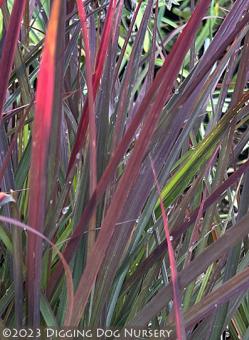
This recent Intrinsic Perennial Garden introduction is quickly earning kudos for its spectacular shades of red and long-lived amenable character. August brings cardinal-red accents to lush dark green blades that define a substantial straight-up clump, while unique 3-branched inflorescences with bright red pollen sacs roost above. Boasting fiery scarlet-red and purple hues by the first frost, aptly named ‘Red October’ furnishes welcome cover for nesting birds and makes a galvanizing addition to a mixed planting, meadow garden or naturalized space. (PPAF)
Blooms July–October
Size: 5' 0" – 6' 0" high x 2' 0" wide.
Hardy to zone 3.
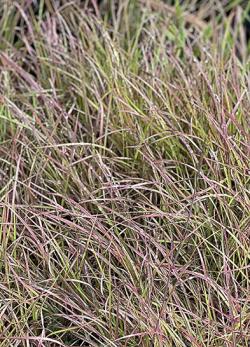
A more refined, compact form of the variable southeastern native, this winning, tough-as-nails cultivar was recently selected by North Carolina Arboretum Curator Terry Dalton. Initially spotted at his fifth-generation farm near Black Mountain, N.C., its upright, glaucous blue-green base looks similar to both Andropogon virginicus and Schizachyrium scoparium, though its pearlescent floral display is singular. Green flowering stalks develop maroon hues and slim stems, which jut out, affording bird-friendly, tuft-like spikelets with sparkling silvery white hairs plus a wondrous glimmering halo. Ideal for a well-drained, midborder position, Split Bluestem’s tidy, low growing habit hosts purple, copper and red fall leaves and tackles drought, but sulks in overly wet soil.
Blooms mid-August–October
Size: 2-1/2' – 3' 0" high x 15" – 18" wide.
Hardy to zone 6.
Bouteloua
Gamma Grass
Bearing the name of two Spanish botanists who were siblings, Claudio and Esteban Bouteloua, these intriguing warm season perennial grasses have an aesthetic appeal and an historic past. Integral elements of the famed North American short grass prairies, otherwise called the Great Plains, Bouteloua are steadfast natives that belong to a large 40 member strong family, extending from Canada to Argentina.
Bouteloua curtipendula (G-0513)
Each $11.00
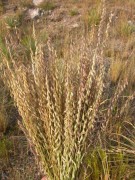
For its distinctive inflorescences, colorful fall foliage and phenomenal drought tolerance, this Midwestern denizen reigns supreme. Purplish oat-like spikelets, uniformly draped along one side of the upright or arching stalks, eventually blanch to a straw hue. Withstanding a wide range of soil types and difficult sites, Side Oats Gamma forms erect, wiry light green clumps that manifest violet, orange and red autumnal shades. Planted in drifts, meandering amid other medium-statured grasses and smaller perennials, a dramatic statement is yours to enjoy, while the birds and butterflies feast on the fodder.
Blooms June–November
Size: 2' 0" – 3' 0" high x 12" – 18" wide.
Hardy to zone 3.
We wish more plants were like this one! This North American native is tough, drought tolerant, and adds delicacy and movement wherever it’s placed. Slightly iridescent, Mosquito Grass offers tiny seed heads borne atop thin, wiry stems. Resembling aerial minnows, the inflorescences dart above 1 ft. clumps of dense, narrow blades. Plant them next to a garden seat or steps where they can be enjoyed at close range.
Blooms June–October
Size: 18" high x 12" wide.
Hardy to zone 4.
Bouteloua gracilis ‘Blonde Ambition’ (G-0538)
Each $12.00
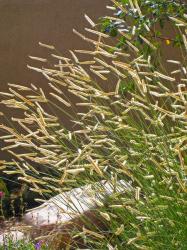
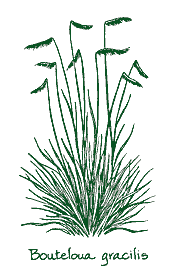
Taller and more energetic than the species, ‘Blonde Ambition’s dense finely hewn tufts provide a blue-green foil for cut-flower-perfect inflorescences, which grow at 90° angles and summon our attention well into winter. The large chartreuse seed heads broadcast eye-catching platinum blonde shades once they mature, waving like splendid flags atop stiff 2 ½ ft. slender stalks. Discovered by David Salmon of High Country Gardens as a chance sport in a Santa Fe, NM garden, this tough heady grass struts golden-brown, orange and red foliar autumn colors, and shimmers when interwoven with Sesleria and flanked by Hydrangea paniculata ‘Pink Diamond’. (pp#22,048)
Blooms June–November
Size: 2-1/2' – 3' 0" high x 2-1/2' – 3' 0" wide.
Hardy to zone 4.
Bouteloua gracilis ‘Hachita’ (G-0553)
Each $11.00
Originally selected by the USDA for its mighty drought-abiding persona, this small-statured narrow bladed grass was collected in 1957 on the semiarid plains south of Hachita, New Mexico. The alluring presentation of delicate reddish purple inflorescences morphs into glittery eyelash-shaped seed heads above a trim close-knit grayish green clump, belying ‘Hachita’s tough-guy reputation. Attractive to both birds and floral arrangers, Blue Grama Grass resents wet poorly-drained locales plus tackles Black Walnut roots, shallow rocky soil, air pollution and erosion. It nestles into the rockery or a more wild venue and forges a mowable lawn substitute.
Blooms June–October
Size: 12" – 20" high x 8" – 12" wide.
Hardy to zone 3.
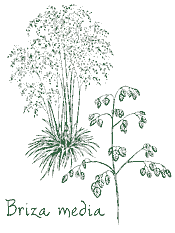
People delight in this Mediterranean native, and its playfully noisy nature has earned it amusing names like cowquakes, didder and dillies; it earns “Rattlesnake˝ for the rattle-like, heart-shaped inflorescences. On slim swaying stems, the small flowers emerge a sparkling green highlighted with red, and dry to a light straw color. Finely textured medium green blades form dense, long-lived evergreen clumps, and forgivingly put up with wind, drought and salt spray.
Blooms April–June
Size: 2' 0" high x 12" wide.
Hardy to zone 4.
Calamagrostis
Extremely durable, undemanding and hearty, this all-purpose clump-forming grass delivers arresting accents to any garden setting.
Calamagrostis x acutiflora ‘Avalanche’ (G-0469)
Each $12.00
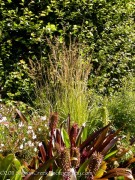
This distinctive newcomer is a variegated form of Calamagrostis ‘Karl Foerster’ first spotted by Steve Schmidt at American Ornamental Perennials. Showcasing dramatically striped foliage, the medium-sized clumps spring to life as a hefty white central band bordered by narrow green margins embellishes each blade. Topped with an airy aura of rose-tinged green plumes that later take on warm, golden hues, ‘Avalanche’s straight-up stance forges a compelling specimen, or when planted en masse, a boldly patterned screen. (PPAF)
Blooms May–January
Size: 5' 0" high x 3' 0" wide.
Zone 4/5.
Calamagrostis x acutiflora ‘Eldorado’ (G-0579)
Each $11.75
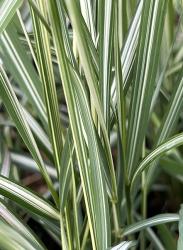
Chanced upon at Garden Gate Growers in Kettle Falls, Washington, this flashy variegated form of ‘Karl Foerster’ wields slender deep green blades heightened by a central golden stripe. The long, narrow vertical plumes are somewhat more open compared to ‘Karl Foerster’s, exhibiting a gossamer-like quality that unfurls in muted mauve tones and ends the season with warm wheat shades atop staunch honey-colored stalks. Triumphant over deer, heavy clay and hot weather, ‘Eldorado’ enjoys sunny, moderately moist environs, while its robust eye-catching profile can be utilized as a straight-standing specimen or planted en masse. (pp#16,486)
Blooms May–December
Size: 5' 0" high x 2' 0" – 2-1/2' wide.
Hardy to zone 4.
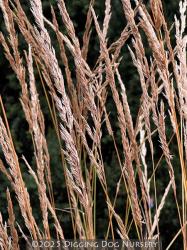
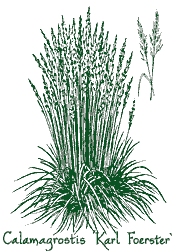
Named for pioneering German nurseryman Karl Foerster, this selection bears loose and airy 12 in. seed heads, which tighten to slender plumes by midsummer. Rising above 2 ft. clumps of narrow green foliage, the inflorescences create an ideal semitransparent veiling effect. Plant with deep green Viburnums to accentuate its golden flowering stems.
Blooms May–January
Size: 5' 0" high x 3' 0" wide.
Hardy to zone 5.
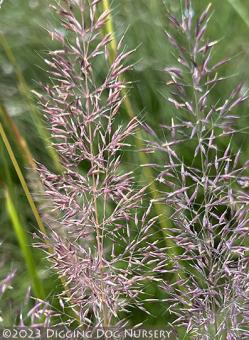
This exceptional new Asian denizen is a vigorous, upright clumping grass. Bleached to a luminous white when mature, sizable, fluffy dusky pink plumes sway above dapper, glossy green blades that are broader and somewhat more coarsely textured than Calamagrostis ‘Karl Foerster’s foliage. With late summer blooms and shapely good looks throughout the season, Caspian’s undemanding habit provides butter-yellow fall foliage, craves adequate moisture and tolerates light shade plus a range of sites.
Blooms August–November
Size: 4' 0" high x 2' 0" wide.
Hardy to zone 4.
Calamagrostis arundinacea ‘Overdam’ (G-0005)
Each $11.75
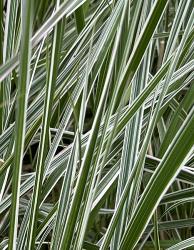
Overdam is a choice new variegated selection of our favorite vertical accent plant, Calamagrostis. Its a bit smaller and more refinded than its parent, enabling Overdam to fit well in the intimate garden, or by a pool or patio. Golden inflorescences tower almost 3 ft. above tufted 15 in. clumps of foliage striped green and white with a blush of pink.
Blooms July–November
Size: 4' 0" high x 2' 0" wide.
Hardy to zone 5.
Calamagrostis brachytricha (G-0067)
Each $11.75
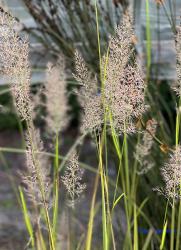
Enlivened by rosy-maroon plumes, this warm season grass is native to the moist woodlands of eastern Asia. The inflorescences stay open and feathery, even when they dry, and eventually pale to an elegant silvery gray. Magical both in an arrangement or outside when the wind blows, the panicles leap from a glossy green clump of upright and curving blades. Calamagrostis brachytricha’s medium-sized stature can grace a container or a mixed border.
Blooms September
Size: 4' 0" high x 2' 0" wide.
Hardy to zone 4.
Calamagrostis x ‘Cheju-do’ (G-0570)
Each $12.25
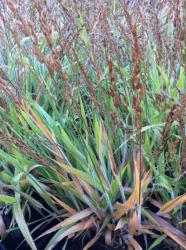
The minute white hairs lining arching medium green blades glisten with dew, while narrow, loosely feathered caramel-colored inflorescences loll above. Not as tall as Calamagrostis x ‘Karl Foerster’ and well-suited for gardens short on space, this relatively new soft-looking Calamagrostis develops an adaptable low maintenance clump that transmutes cozy pinkish amber hues in autumn. ‘Cheju-do’ can be featured as a stylish specimen, planted in drifts around large shrubs or small trees and is especially lovely skirting a Japanese Maple.
Blooms August–October
Size: 2' 0" – 3' 0" high x 2' 0" – 3' 0" wide.
Hardy to zone 5.
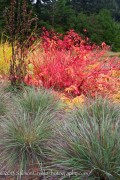
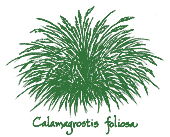
Garnished by violet tinges, low loose mounds of glaucous blue-gray blades generally remain evergreen throughout the year and set this California native apart from other North American Calamagrostis species. Slender, tapering pinkish purple panicles sojourn just above the relaxed foliage in a comely fountain-like fashion and by early summer adopt luminous flaxen hues. Cape Mendocino Reed Grass pouts when it’s hot, appreciates summer irrigation and looks artful either as a large-scale ground cover or peppered throughout mixed borders and naturalized meadows.
Blooms May–November
Size: 18" high x 2' 0" wide.
Hardy to zone 8.
This new amenable evergreen grass arose from a Calamagrostis foliosa and Calamagrostis nutkaensis ‘The King’ cross made by Josh Williams at Cal Flora Nursery. The winsome midsized medium green mound evokes its Calamagrostis nutkaensis heritage, yet presents a lower profile, while the mature lanky, thick honey-colored tassels are somewhat more arching than Calamagrostis foliosa’s. Defying deer and drought, easy-care ‘Little Nootka’ can be nudged into meadows, mixed borders, woodland margins and cut arrangements.
Blooms June–August
Size: 12" – 2' 0" high x 12" – 2' 0" wide.
Hardy to zone 7.
Carex
Sedge
A diverse genus comprised of nearly 1000 species, most Carex originate in the moist habitats of temperate climates. Easily grown, our winning selections produce a variety of different colored leaves that promise to soften those sharp edges in your garden.
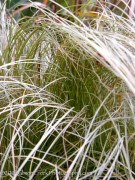
Applauded as one of the most distinctive native New Zealand grasses, this Carex spotlights a frosted fountain of gracefully cascading hairlike blades. The iridescent light green leaves twist their tips and gleam with pewter highlights, while staging a dense evergreen clump that spills over rocks, walls or a favored patio container.
For an especially fluid display, ‘Frosted Curls’ is best planted en masse on a slope where its trailing foliage appears to flow like water.
Size: 12" high x 12" wide.
Hardy to zone 7.
Each $11.00
Indigenous to the wooded floodplains, blackland prairies, calcium-rich glades and acidic springs of primarily the lower southeastern U.S., this robust, hard-working grass crafts a dense, well-mannered evergreen colony. Slow spreading rhizomes support the slender, arching dark green blades, glistening with verdant splendor beneath sheer pale green spring flowers that later morph into pendulous wheat-style golden-brown seed spikes. Distinguished by versatility and a lush, fine textured aspect, Cherokee Sedge is widely utilized in meadowscapes, shady borders and waterside venues as well as for erosion control and massed ground covers. It prefers moist soil and dappled light, but will abide dry sunny sites.
Blooms April–June
Size: 18" – 2' 0" high x 2' 0" – 3' 0" wide.
Hardy to zone 6.
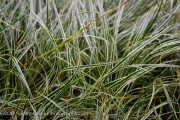
Glistening, dark green slender leaves embellished with crisp white margins and small purplish white flowers on triangular stems hallmark this neatly tufted variegated Sedge. Fully evergreen in milder climates, the sturdy fine textured mound spreads slowly, casting a long lasting sprightly charm upon the rockery, woodland beds or patio pots. ‘Snowline’ relishes light shade and loose moist soil, withstands tree roots, wards off deer and, if planted closely, makes a picturesque easy to maintain ground cover.
Blooms May
Size: 9" – 15" high x 10" – 18" wide.
Hardy to zone 5.
Each $11.00
Endemic to Europe and Asia, Grassland Sedge’s deep green and lustrous, thin evergreen blades nimbly arch out from a clumping base, yielding inconspicuous brownish blooms held by lax wiry stems. Once established, the fast growing and versatile Carex divulsa can handle an array of situations: some drought, boggy areas, tree roots, sun or shade, and foot traffic, including the 4-legged kind. However, regular watering and a trim every 6 months will ensure the most vigorous growth. You can space it closely and mow for a turf-like effect, plant multiples as a luxurious ground cover in a small or large area or create an intriguing vignette with Arctostaphylos ‘Radiant’ and Festuca ‘Superba’.
Blooms May–June
Size: 18" – 2' 0" high x 2' 0" wide.
Hardy to zone 7.
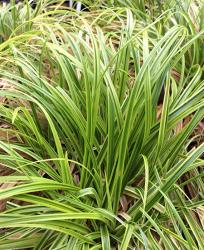
Nishiki means “brocade,” and it rightly describes the variegated blades of this superb selection, which comes to our country from Japan’s Gotemba Nursery. Forming a tidy, fountain-like mound, each slender leaf has a green central stripe emargined in radiant yellow. Long-lived and durable, ‘Kaga Nishiki’ imparts bright accents to verdant broad-leafed perennials in the border.
Size: 8" – 10" high x 18" wide.
Hardy to zone 6.
Each $11.75
“A very beautiful sedge” is how E. A. Bowles once described his prized discovery from Norfolk, England. Distinguished by subtle and variable longitudinal green stripes, this courtly, rounded sedge beams graceful clear yellow blades, which become more brilliant in sun and turn lime-yellow in shade. ‘Aurea’s dense, flowing tussock enlivens moist mixed borders, waterside plantings and rock gardens. Combine with other gilded foliage or with the contrasting leaves of Pulmonaria ‘Silver Bouquet’ and a stunning statement is yours to enjoy.
Size: 15" high x 18" wide.
Hardy to zone 5.
Carex elata ‘Knightshayes’ (G-0096)
OUT OF PRODUCTION AT THIS TIME
Email me when this plant is available
Solidly colored in clear golden yellows, this Carex's graceful hummock will energize the hohum corners of your garden. With upright and arching, evergreen foliage, 'Knightshayes' requires moisture and bright shade to retain the gilt hues. Try establishing singly or en masse near ponds, streams, in a damp border or even in water, where its glowing accents and reflections are sure to beckon.
Size: 15" high x 18" wide.
Hardy to zone 5.
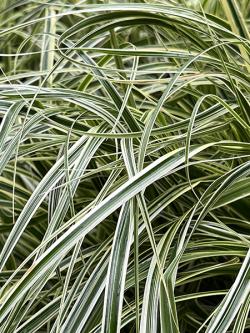
This new Exceptio Plants introduction has a lot to vaunt: sauve looks plus superb evergreen pep coupled with a fast-growing extralarge habit that’s more sun and heat tolerant than many of its Carex oshimensis kin. Dark emerald-green centers enveloped by lucent creamy-white margins garnish the gleaming cascade of long, narrow, arching variegated leaves. A premiere container showpiece, easy-care ‘Feather Falls’ can be planted as a specimen or en masse adorning slopes, pathways and shady mixed borders, while it escorts broader-leafed perennials like Saxifraga, Epimedium or Asarum. (pp#26,199)
Size: 18" – 2' 0" high x 2' 0" – 3' 0" wide.
Hardy to zone 6.
Carex flacca (glauca) (G-0099)
Each $11.00
With its sea of striking blue, Carnation-like foliage, this handsome Carex is aptly named. Glaucous, narrow blades create a noninvasive, slowly spreading mass. Purple-black spikes appear to float like a subtle mist just above the solid, jointless flowering stems. Easy to establish and indispensable as a low ground cover, Carex flacca tolerates drought, adapts to an array of growing conditions and effectively interweaves a tapestry of Heathers.
Blooms May–June
Size: 6" – 15" high x 12" – 15" wide.
Hardy to zone 4.
Carex flacca ‘Burton’s Blue’ (G-0554)
OUT OF PRODUCTION AT THIS TIME
Email me when this plant is available
Reminiscent of Dianthus leaves and noticeably broader than the species, the eye-catching ¾ in. wide ultrablue blades grow in an upward arching manner. ‘Burton’s Blue’ produces small purple-black flowers atop its compelling, textural foundation, which makes an ideal, well-behaved evergreen addition to your rock garden or border. Staged in sweeps, as a walkway edging or tucked between boulders, this adaptable slow spreading selection abides full sun, part shade, drought, alkaline soil and even some salinity.
Blooms May–mid July
Size: 12" – 20" high x 10" – 15" wide.
Hardy to zone 4.
Each $11.00
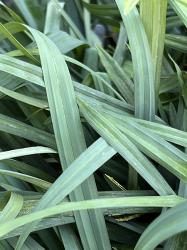
Indigenous to the central and southeastern U.S., this handsome, arching sedge sprouts low, slow-spreading evergreen clumps of narrow, glaucous blue-green leaves. Heightened by creased parallel veins and slender golden-brown seed heads, the amenable small-sized habit appreciates a late winter cutback plus shady moist abodes, yet thrives in average soil and even tolerates dry conditions. Blue Wood Sedge can flank a stream bed, edge a pathway or be utilized as a deer-resistant ground cover for wooded gardens.
Blooms May–June
Size: 6" – 10" high x 6" – 12" wide.
Hardy to zone 5.
Carex flagellifera (Bronze) (G-0532)
OUT OF PRODUCTION AT THIS TIME
Email me when this plant is available
Infused with rich earth tones evoking a Zen-like simplicity, the weeping ultra-fine clump of long and thin, dark chocolate-colored blades sets this mop-top New Zealander apart. Carex flagellifera’s easily melded tones and fluid upright arching form brings textural intrigue to containers, the rockery, walls or borders, whether installed as a stand-alone or a sweep. Arresting when juxtaposed against broad greenery, blue-gray foliage or any brightly hued bloom, Weeping Brown Sedge obliges sun, shade, moisture and somewhat dry conditions, and remains evergreen where winters are mild.
Size: 15" – 18" high x 2' 0" wide.
Hardy to zone 6.
Carex morrowii ‘Ice Dance’ (G-0088)
Each $12.00
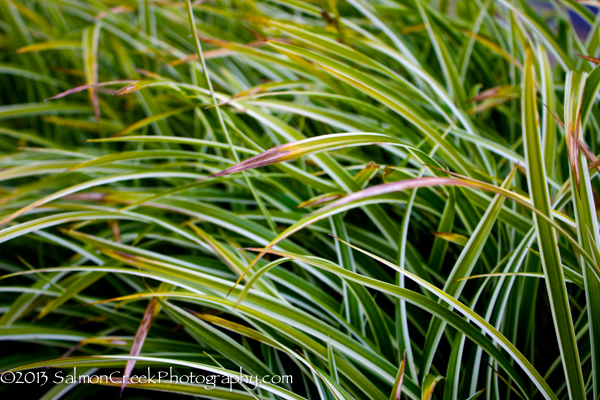
Introduced by Barry Yinger, long-lived ‘Ice Dance’ comes to us from the woodlands flanking Japan’s low-lying mountains. Dark emerald in color, the reflexed, leathery leaves are shiny and heightened by creamy white margins. This tidy evergreen ground cover is not invasive; its spreading rhizomes form a coarsely textured carpet that is somewhat drought tolerant once established.
Size: 12" high x 12" wide.
Hardy to zone 5.
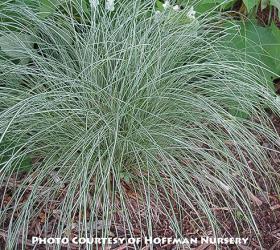
Whatever visions the cultivar name may conjure, the thread-like glimmering foliage is sure to champion. Collected by Barry Yinger during a 1970 Japanese excursion, this carefree variegated grass generates a touchable fountain-shaped mop of extrathin, longitudinally-striped green and white foliage that shrugs off deer and readily subdues angular features. ‘Silk Tassel’s elegantly cascading clump looks fantastic massed in a woodland planting, lodged alongside rocks or positioned pondside.
Size: 12" high x 2' 0" wide.
Hardy to zone 5.
Carex muskingumensis ‘Little Midge’ (G-0521)
Each $11.00
Truly pint-sized in all aspects, this easily cultivated fine-hewn Sedge was introduced by Limerock Nursery of Pennsylvania. Thin, tapered bright green blades resemble palms as they radiate out from relaxed stem tips. Best enjoyed up close, the slow spreading ‘Little Midge’ is a superb option for containers, bog gardens, the rockery, small water features or en masse plantings, which once established mimic a verdant rug. Dwarf Palm Sedge thrives with ample moisture, but is tolerant of drier conditions.
Size: 8" – 12" high x 8" – 12" wide.
Hardy to zone 4.
While the species inhabits moist North American woodlands and meadows, this uniquely textured sport, discovered in landscape architect Wolfgang Oehme’s garden, is somewhat drought tolerant once established. First a solid color, later enhanced with narrow yellow edges, the bright green blades are tapered and arranged horizontally like palm fronds on mostly upright triangular stems, knitting a tropical-styled, semideciduous ground cover.
Versatile and deer resistant, ‘Oehme’s slow spreading steadfast clump produces chocolate-colored spiky inflorescences, handles sun or shade, favors ample moisture, especially when its hot and looks just right along a walkway, streamside, or in a container.
Blooms June
Size: 18" – 2' 0" high x 2' 0" wide.
Hardy to zone 4.
Touted as one of the most graceful of the variegated sedges, this clump-forming evergreen Carex captivates us with dense and dapper, gracefully weeping blades. A butter-colored median band daringly lights up each long, fine textured dark green leaf. Carex oshimensis dwells amid the rock-laden slopes and dry woodlands on Japan’s main island, Honshu, rendering ‘Evergold’ a choice contender for your favorite pot, the rockery or woods. Smoothing over hard edges and luminous en masse, it happily obliges varied conditions, except intense hot weather.
Size: 10" – 14" high x 12" – 2' 0" wide.
Hardy to zone 6.
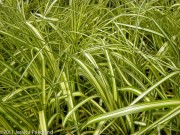
Arching upward and out, this Carex’s lush foliage is elegant. A glinting cascade of refined, evergreen blades presents dark green margins with broad, alabaster-colored central stripes that mature to creamy yellow. Languishing if it’s too hot, slow spreading ‘Gold Strike’ thrives in moist, well drained sites, and makes a bold statement when its densely set, variegated tussocks are planted in a meandering swath amidst Pulmonaria ‘Benediction’ or Epimediums.
Size: 15" – 20" high x 2' 0" wide.
Hardy to zone 6.
Each $11.00
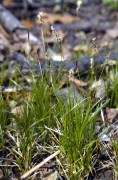
Wish you had a plush green no-mow carpet that can tackle dry conditions and requires little care? This low-growing, fine textured Sedge may be just what you’re looking for. Slowly spreading by reddish brown rhizomes, Carex pensylvanica makes a soft-looking fountain-like ground cover with delicate semievergreen blades plus white-edged purple and brown thimble-shaped inflorescences. Indigenous to the thickets and oak inhabited woodlands of eastern and central North America, Oak Sedge prospers in well-drained shady expanses, such as underneath deciduous trees and large perennials, or as a lawn substitute, where there’s not much foot traffic.
Blooms May
Size: 6" – 12" high x 8" – 15" wide.
Hardy to zone 4.
Carex pensylvanica ‘Straw Hat’ (G-0586)
Each $12.00
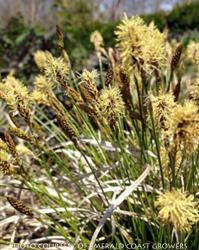
The bevy of eye-catching ½ in. wide, woolly, flaxen-yellow inflorescences achieves a showier and more generous display than its native North American counterpart. Evoking the namesake, ‘Straw Hat’s sprightly springtime blooms crest arching stalks and ultrathin semievergreen blades. Supported by slow-creeping rhizomes, the low, soft-looking medium green mound can be planted in drifts to create a pleasing grassy ground cover that relishes sun-dappled shade, loose well-drained loam and somewhat dry sites. (pp#29,423)
Blooms mid April–May
Size: 9" – 12" high x 12" – 15" wide.
Hardy to zone 4.
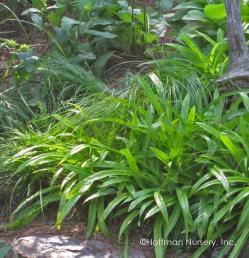
Deemed one of the most striking native woodland sedges, Carex plantaginea ranges from Maine to South Carolina and west to Minnesota and Alabama. Crafting a snug, lustrous deer-proof clump that’s most effective when massed, the dimpled, 1 in. wide lime-green blades are anchored by maroon-hued leaf sheathes beneath a bird-friendly display of cylindrical purplish brown inflorescences. Small-statured Seersucker Sedge promises bold mostly evergreen texture along woodland pathways or in mixed borders and rock gardens, where it withstands occasional drought, yet appreciates rich, adequately-moist niches plus a late winter cut back.
Blooms April–May
Size: 8" – 12" high x 12" – 18" wide.
Hardy to zone 4.
OUT OF PRODUCTION AT THIS TIME
Email me when this plant is available
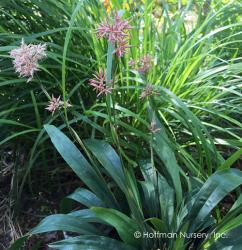
Head-turning spiky pink flowers on sturdy scapes make this exceptional new grass a standout among Carex. Native to both Vietnam and Southern China, Carex scaposa was recently discovered by U.S. National Arboretum director, Dr. Richard Olsen, at Kunming Botanical Garden. The unique, honeybee-friendly inflorescences garnish handsome, broad green blades—arching, lustrous and somewhat lax—each sporting a long tapered point. Tailor-made for shady patio containers and other low-light garden niches, aptly named Cherry Blossom Sedge vows a repeat bloom in autumn plus a lush, nearly evergreen habit that partners well with Pulmonaria ‘Diana Clare’, Beesia deltophylla and Athyrium ‘Ghost’.
Blooms mid July–August & late September
Size: 12" high x 18" – 2' 0" wide.
Zone 6b.
Carex ‘Silver Sceptre’ (G-0561)
Each $11.75
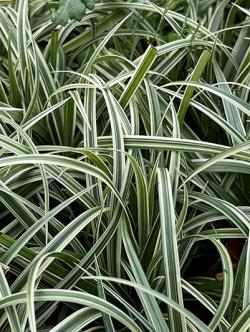
Originally cultivated by Japan’s variegated grass enthusiast, the late Dr. Yokoi, slow spreading ‘Silver Sceptre’ yields bright white margins that are big on sparkle, though the long, arching narrow green blades span a mere 1/8 in. Greenish brown flower spikes lend subtle interest on triangular stems, while the compelling silver-laced foliar accents jazz up containers or massed plantings. Utilized as an obliging evergreen ground cover, ‘Silver Sceptre's refined habit tackles deer, drought and various soil conditions plus heavy shade and cold winters.
Blooms May
Size: 8" – 12" high x 12" – 18" wide.
Hardy to zone 5.
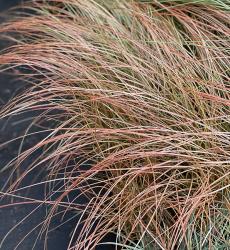
A cozy fusion of colors—from dark chocolate and cappuccino to reddish bronze—distinguish this fine textured evergreen sedge. Whether positioned in a border, cascading over a wall or embellishing a container, the long and narrow, arching foliage fashions a loosely arranged, graceful mound whose rich warm tones juxtapose green and golden leafage to great affect.
Carex tenuiculmis favors moist soil, and can be brought inside wherever it’s not winter hardy.
Size: 12" – 15" high x 12" – 15" wide.
Hardy to zone 7.
Each $11.00
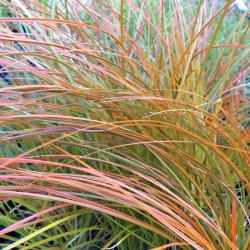
The exotic flair of lucent orange foliage paints the garden’s leafy green canvas nearly year round. Long narrow strands first emerge an olive green and later transmute stunning golden brown, copper and orange highlights. With its upright and dense arching tuft, easy-to-grow Carex testacea is a hardy drought-tolerant grass that entices gardeners, but not deer, plus insists on full sun to preserve the extraordinary hues, and good drainage. Let this evergreen New Zealand native spill over a container’s edge or snuggle up to Yucca ‘Color Guard’, Heuchera ‘Blackout’ and Euphorbia myrsinites.
Size: 18" – 2' 0" high x 18" wide.
Hardy to zone 6.
This refined Carex’s calling card is the sassy orange, red and copper tones that infuse its slim foliage with scene-stealing allure. Projecting the most vibrant coloration in full sun, the graceful greenish bronze blades are upright and arching beneath subtle mahogany-colored flowers. Appreciative of moist well-drained soil, ‘Prairie Fire’s close-knit mostly evergreen tuft brings electrifying, easy-care accents to containers, mixed borders or rock wall plantings, where it withstands dry conditions once established and enlivens gloomy winter days in milder locales.
Blooms July–August
Size: 18" – 2' 0" high x 18" – 2' 0" wide.
Hardy to zone 6.
Each $11.00
Sauntering throughout open woodlands and dry sandy meadows from New York to Georgia and west to Nebraska and Texas, this resourceful evergreen Carex serves up small, flowing mat-like clumps characterized by thin, wispy dark green leaves plus petite green flower spikes. A long-lived undemanding grass, Catlin Sedge abates erosion, prefers dappled sunlight, tolerates moist or dry conditions and makes a water-wise lawn alternative that abides minimal foot traffic and rarely needs mowing. It can spread between stepping stones, carpet forest margins and accompany bonsai specimens or Japanese Maples in containers.
Blooms April–May
Size: 5" – 12" high x 12" – 2' 0" wide.
Hardy to zone 5.
Chasmanthium latifolium (G-0101)
Each $12.00
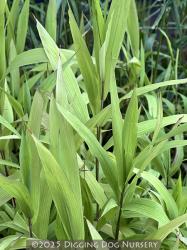
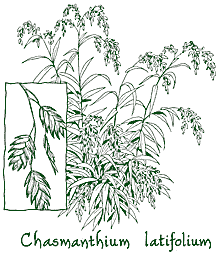
A versatile performer, clump-forming Wood Oats calls the American Southeast its home. Whether surging upright in a sunny spot, or growing more relaxed in a shadier location, the bamboo-like rich green foliage makes a pendulous foil for its prized flowers. Bearing a resemblance to oats, pale green spikelets dangle on slender arching stems. As autumn arrives, the showy inflorescences turn a reddish bronze, while broad blades are set aglow with a vibrant gold. Paling to light salmon, the flowers stay intact through winter and are lovely when frosted with snow. Sultry and verdant, this warm season grass brings captivating detail to the border or an arrangement, handles salt spray, and even endures dry soil in dappled shade.
Blooms July–August
Size: 3' 0" – 4' 0" high x 2-1/2' wide.
Hardy to zone 5.
Chionochloa flavicans (G-0496)
Each $12.25
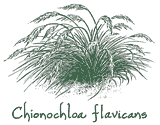
Native to the cliffs and rocky outcrops of New Zealand’s North Island, this graceful long-lived grass develops a glossy green tussock. Creamy-silvered plumes elegantly drape on lax stems above the cascading, loosely arranged evergreen foundation. Enduring drought and various soil types, Chinochloa flavicans’ adaptable habit can stand alone or be planted in multiples to create a fluid-looking swath that looks especially impressive on slopes.
Blooms July–August
Size: 3' 0" – 4' 0" high x 3' 0" – 4' 0" wide.
Zone 7/8.
A rarely cultivated New Zealand denizen, this long-lived evergreen grass promises a graceful appearance. The lanky slender blades forge compact tawny-green tufts beneath persistent silver-laced panicles that roost upon pliant, tall arching stems. Well-suited for massing or as a stand-alone specimen, Chionochloa rigida’s shimmering inflorescences can linger with other carefree companions such as Euphorbia ‘Bruce’s Dwarf’ or Phlomis tuberosa.
Blooms June-August
Size: 3' 0" high x 0" – 8" wide.
Hardy to zone 5.
Chondropetalum tectorum (G-0027)
Each $15.00
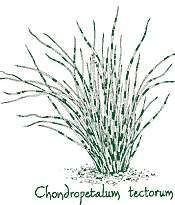
This long-lived plant belongs to the Restionaceae, a family of rushlike evergreens from the Cape region of South Africa. Papery chocolate-brown bands and long lasting dark brown seed heads contrast with the wiry, deep green stems and small greenish inflorescences. Ideal for low maintenance gardens, this sculptural beauty is hardy to 20° and prefers sandy, well drained soil and dry summers. It has also, however, withstood our wet winters.
Blooms September–October.
Size: 5' 0" high x 5' 0" – 7' 0" wide.
Hardy to zone 9.
Deschampsia
Tufted Hair Grass
An easily grown, durable cool season grass, Deschampsias hail from the temperate regions of North America, Europe and eastern Asia. Wispy seed heads stretch in airy fans above finely-cut deep green tufted clumps, lending a delicate hazy quality that is put to best effect by planting en masse against a dark or solid backdrop. They can enhance woodland peripheries, moist meadows and perennial borders plus fresh or dried arrangements.
Deschampsia cespitosa ‘Goldgehänge’ (G-0038)
Each $12.00
The bright golden veil of nodding straw-colored flowers surely inspired this Deschampsia’s cultivar name. Dense forest green tussocks anchor slightly pendulous stems dressed with fine textured, ethereal inflorescences that guarantee a glowing performance especially when massed and set against dark-leafed woodies like Parrotia persica.
Blooms July–October
Size: 2' 0" – 3' 0" high x 2' 0" wide.
Hardy to zone 4.
Deschampsia cespitosa ‘Goldtau’ (G-0556)
Each $12.00
Defined by narrow arching deep green foliage, a winsome sturdy mound propels emerald-hued stems, exploding into sheer sprays of distinctive long-lasting yellow-green flowers. The lithe inflorescences exhibit warm bronze tones when mature and provide an enticing winter presence. Smaller and more compact than other cespitosa species, this undemanding, all-purpose grass develops a dense semievergreen habit that can be grouped along a pathway or sited among Echinops ‘Blue Glow’ and Phygelius ‘Peach Trombone’.
Blooms July–October
Size: 12" – 2' 0" high x 12" wide.
Hardy to zone 4.
Deschampsia cespitosa ‘Pixie Fountain’ (G-0587)
Each $12.00
A Jelitto Seeds introduction, this petite Deschampsia sprouts a tight and tidy evergreen clump of slim silver-green blades that are extremely cold hardy. Wide frosty-white panicles lend glimmering ethereal accents above grass-like foliage, and later transmute warm chocolate hues upon maturity. Most striking when planted in sweeps, pest-free ‘Little Pixie’ tolerates shade, nourishes birds, and is ideal for small-scale spaces, wooded areas, wildlife gardens or along ponds and streams.
Blooms July–October
Size: 16" – 2' 0" high x 12" – 18" wide.
Hardy to zone 2.
Deschampsia cespitosa ‘Schottland’ (G-0008)
Each $12.00
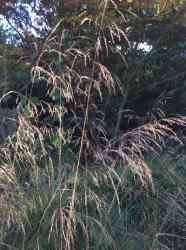
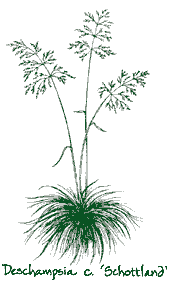
The silky, new light green flower heads of ‘Schottland’ invite a touch each time we pass by. One of the largest Deschampsias, this Scottish born selection spawns inflorescences that float nearly 3 ft. above a neat rounded clump of finely-cut deep green foliage. Utilize as a specimen in a mixed border or in a more untamed arena.
Blooms July–December
Size: 3' 0" – 3-1/2' high x 2-1/2' wide.
Hardy to zone 4.
Deschampsia cespitosa ‘Tardiflora’ (G-0526)
Each $11.75
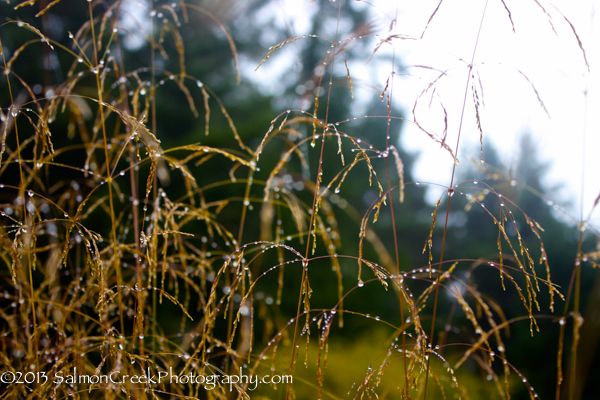
This Karl Foerster innovation boasts small dreamy looking inflorescences, whose wide airy consortium sparkles in gold, silver and purplish shades. Topping abundant flowing panicles, they appear later than the species, mature to an amber color and linger most of the winter. Arching close-knit narrow blades, edged by in-rolled margins, compose the low growing emerald green tussock that makes a tidy verdant companion for Eryngium bourgatii and Aster asperulus.
Blooms July–December
Size: 2' 0" – 3' 0" high x 2' 0" – 3' 0" wide.
Hardy to zone 4.
Meandering across dry open wooded areas, slopes and grasslands in North America, Europe and Asia, this tight-set semievergreen grass forms a diminutive trim tussock of arching wire-thin deep green blades beneath wide frothy inflorescences. The minute purple and bronze flowers populate swaying diaphanous panicles, which mature to gold after the seed ripens and are cherished by floral arrangers as well as cardinals, finches and snow buntings. Obliging drought and shade, Crinkled Hair Grass is an attractive formidable candidate for well-drained woodland gardens, borders or the rockery.
Blooms July–October
Size: 2' 0" – 2-1/2' high x 12" – 18" wide.
Hardy to zone 4.










